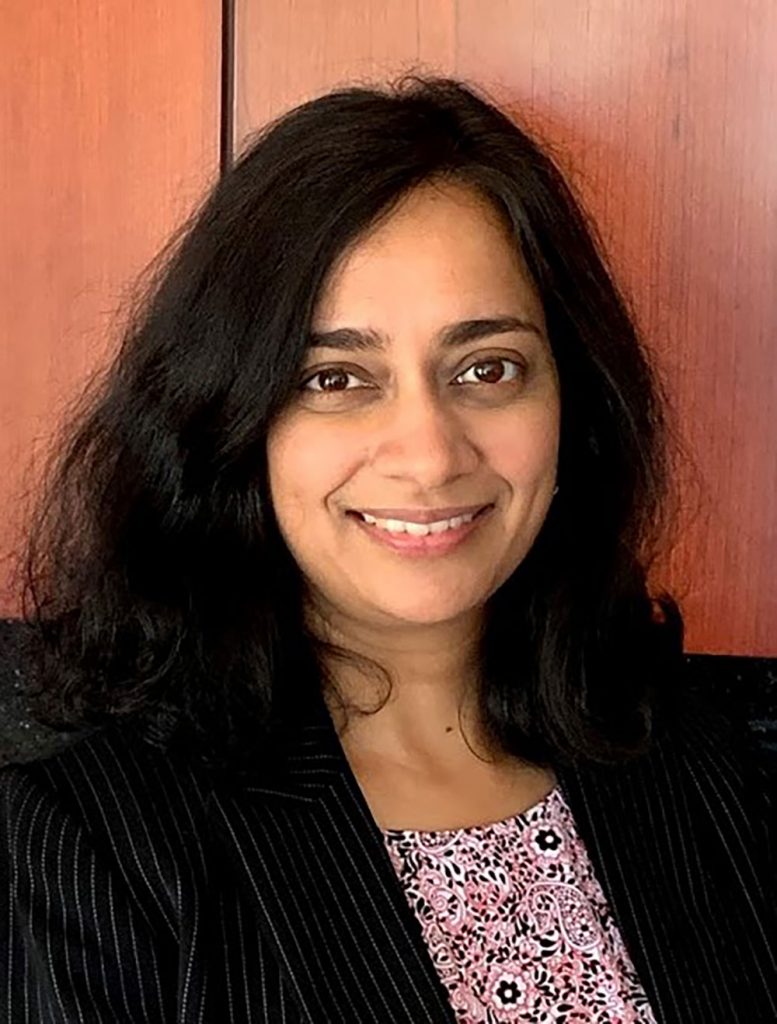
(Photo by Srihari Narasimhan)
Although managers and colleagues had often called her work “exceptional,” chemist Krupa Ramasesha was still surprised to learn she had earned a 2022 DOE Early Career Research Award.
“I am thrilled to receive this award because it will allow me and my team to focus a large portion of our efforts on expanding our research program to tackle important problems at the frontiers of photocatalysis and interfacial chemistry,” she said.
Shedding light on tiny spaces
With the DOE Early Career Research Award, Krupa plans to launch an in-depth study of how interactions of nanoparticles with light drive chemistry.
“Certain types of metallic nanoparticles are characterized by very strong interactions with light,” she said. “Based on the size, shape and composition of the metallic nanoparticle, light in the near-infrared or visible wavelengths can excite the so-called localized surface plasmon resonance, which is characterized by the collective oscillation of electrons in the nanoparticle.”
Plasmon resonance decays rapidly by transferring energy and charge to its surroundings. When molecules are adsorbed on the surface of these metallic nanoparticles, such charge and energy transfer processes can trigger chemical transformations, like bond breakage, in the adsorbed molecules, thus initiating reactions.
“The goal of my work under the early career award will be to develop a fundamental understanding of the electronic interactions between molecules and metallic nanoparticles. These electronic interactions form the foundation for energy and charge transfer processes that immediately follow light excitation,” Krupa said.
She believes this insight will help advance the field of plasmonic photocatalysis, where plasmonic metal nanoparticles are used as antennas for absorbing and channeling solar radiation to drive chemical reactions.
“There are numerous open questions surrounding the nature of electronic interactions and the mechanisms for energy and charge transfer between molecules and nanoparticles,” Krupa said. “We will address these questions using a combination of cutting-edge X-ray and infrared spectroscopies, which can monitor the transfer of charge and energy with site-specificity on the natural femtosecond to picosecond (one quadrillionth to one trillionth of a second) timescales characteristic of electronic and atomic motion.”
Finding inspiration in her parents
Krupa’s curiosity and enthusiasm for her research, and her earliest inspiration, come from childhood.
“My parents are both chemists and academics,” she said. “They have had decadeslong successful research and teaching careers — my father, S. Ramasesha, in theoretical chemistry and my mother, Sheela Ramasesha, in materials chemistry — so I was exposed to research life very early on. Their excitement for science is infectious and their knowledge vast; any question I had as a kid about the world around me would turn into an exciting discussion that spawned more questions and led to a deeper understanding. I learned various science and math concepts from them through these spontaneous conversations and by spending time in their labs and offices.”
Krupa said she witnessed their research triumphs, setbacks, hard work and perseverance firsthand, fueling her own research career without any romantic notions of what success in science is and what it takes to get there. She often reflects on and draws from what she observed from her parents as she thinks of her own career.
“My parents are fantastic examples of having a successful research career as well as a fulfilling personal life, and words cannot express how grateful I am for their inspiration and example,” Krupa said.
Forging ahead and forging a new future

Krupa said she is as excited and fascinated by science now as she was as a teenager, thanks in large part to those who helped her along the way.
“I am indebted to my undergraduate, graduate and postdoctoral research advisers who trained me scientifically and technically to take on research challenges in my field,” Krupa said. “I am thankful to my past and present colleagues, particularly my team of postdocs, technologists and collaborators, for all their hard work and dedication, as well as to Sandia management that helped me commence my research program, and more recently, advised me through the proposal writing process for the early career award.”
But Krupa relies most on her team at home.
“My husband, Srihari Narasimhan, and our two daughters bring immense joy and meaning to my life,” she said. “I am incredibly grateful to my family for their love and support, for providing the necessary perspective and for being sounding boards for new ideas.”
Krupa believes this exciting new research path will not only be professionally fulfilling but will also provide an opportunity to help address the climate crisis, in some small way, for the sake of her kids and their generation.
“It would be terrific if we are successful in resolving the mechanisms of charge and energy transfer between metallic nanoparticles and molecules, as this could inform how tailoring the properties of nanoparticles and light excitation can selectively drive certain chemical reactions,” she said. “Many steps down the line into the future, this could help alleviate the considerable dependence on fossil fuels for driving industrial chemical reactions at high temperatures. The long-term aspiration is to provide a scientific knowledge base required to scale up plasmonic photocatalysis such that solar radiation can be efficiently harnessed to drive large-scale chemical reactions.”
Krupa’s project, Unraveling the Ultrafast Chemical Dynamics Governing Non-Equilibrium Molecule Nanoparticle Interactions, is now fully funded for the next five years by the DOE Early Career Research Award program.